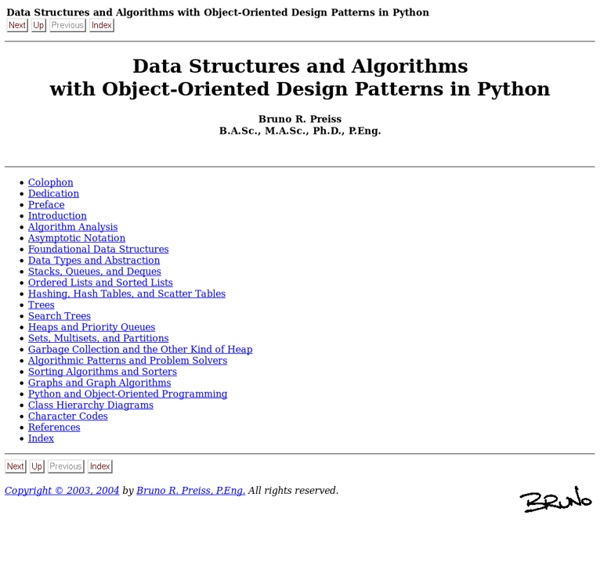



Python for Fun This collection is a presentation of several small Python programs. They are aimed at intermediate programmers; people who have studied Python and are fairly comfortable with basic recursion and object oriented techniques. Each program is very short, never more than a couple of pages and accompanied with a write-up. I have found Python to be an excellent language to express algorithms clearly. From many years of programming these are some of my favorite programs. Many thanks to Paul Carduner and Jeff Elkner for their work on this page, especially for Paul's graphic of Psyltherin (apologies to Harry Potter) and to the Twisted developement team for their Lore documentation generator to which all the other web pages in this collection have been recently adapted. Chris Meyers
labs :: Python beginner's mistakes Every Python programmer had to learn the language at one time, and started out as a beginner. Beginners make mistakes. This article highlights a few common mistakes, including some I made myself. Beginner's mistakes are not Python's fault, nor the beginner's. They're merely a result of misunderstanding the language. However, there is a difference between misunderstanding (often subtle) language features, vs misunderstanding the language as a whole, and what can (and cannot) be done with it. To put it another way, the mistakes in this article are often cases of "the wrong tool for the job", rather than coding errors or sneaky language traps. Mistake 1: trying to do low-level operations Python is sometimes described as a VHLL, a Very High-Level Language. This doesn't mean that it isn't possible to do these things with Python; but it's probably just not the right language for these jobs. Mistake 2: writing "language X" code in Python This is a mistake that is almost unavoidable. Some advice
Text Processing in Python (a book) A couple of you make donations each month (out of about a thousand of you reading the text each week). Tragedy of the commons and all that... but if some more of you would donate a few bucks, that would be great support of the author. In a community spirit (and with permission of my publisher), I am making my book available to the Python community. Minor corrections can be made to later printings, and at the least errata noted on this website. Email me at <mertz@gnosis.cx> . A few caveats: (1) This stuff is copyrighted by AW (except the code samples which are released to the public domain).
Python 201 -- (Slightly) Advanced Python Topics Dave Kuhlman Email: dkuhlman@rexx.com Release 1.00June 6, 2003 Copyright (c) 2003 Dave Kuhlman Permission is hereby granted, free of charge, to any person obtaining a copy of this software and associated documentation files (the "Software"), to deal in the Software without restriction, including without limitation the rights to use, copy, modify, merge, publish, distribute, sublicense, and/or sell copies of the Software, and to permit persons to whom the Software is furnished to do so, subject to the following conditions: The above copyright notice and this permission notice shall be included in all copies or substantial portions of the Software. Abstract: This document is a syllabus for a second course in Python programming. Contents This document is intended as notes for a course on (slightly) advanced Python topics. Defining a regular expression is to provide a sequence of characters, the pattern, that will match sequences of characters in a target. Comments:
The Django Book The Art of Programming Programming and art can no longer be thought of as totally different worlds. They join each other as one in computer games, mobile apps, and software. 3D graphic arts and animated graphics give life to each game you play and each application you use. Computer graphic arts and modern programming are now interlaced as logic just is one with the creativity of geniuses. Einstein often mentioned that when he hit a logical stumbling block, he grabbed his violin and stimulated his creative juices to solve the problem. Start Here: Python 3x Programming for Beginners This is a short, free, e-book, to download and begin your journey into Python 3x programming. Intro To Game Making A short article to introduce game making and game development for the beginnner. Free Python 3x Code Free Python 3 code to use in commercial or non-commercial projects. Free Resources for Game Making Free graphics, assets, 3D models, fonts, sounds, music, and other resources to make games.
The Programming Historian - 1st edition Python Programming Python Programming From Wikibooks, open books for an open world Jump to: navigation, search This book describes Python, an open-source general-purpose interpreted programming language available for a broad range of operating systems. Contents[edit] Intro[edit] Overview Getting Python Setting it up Interactive mode Self Help Basics[edit] Creating Python programs Variables and Strings Basic syntax Sequences (Strings, Lists, Tuples, Dictionaries, Sets) Data types Numbers Strings Lists Tuples Dictionaries Sets Basic Math -- redundant to "Operators" Operators Control Flow Decision Control Conditional Statements Loops Functions Scoping Input and output Files Text Modules Classes Exceptions Errors Source Documentation and Comments Idioms Advanced[edit] Decorators Context Managers Reflection Metaclasses Namespace Tips and Tricks Modules[edit] Standard library modules[edit] Standard Library Regular Expression External commands XML Tools Email Threading Sockets GUI Programming Tkinter CGI interface WSGI web programming Extracting info from web pages Math